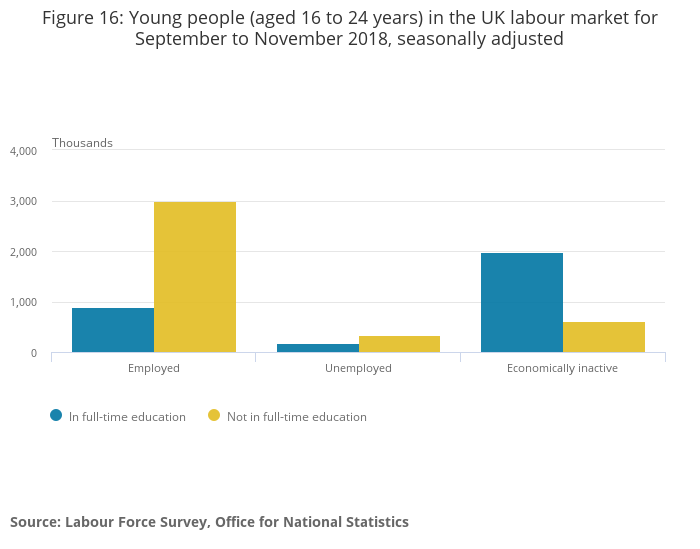See the latest youth employment figures and UK labour market statistics for January 2019.
The latest ONS data shows the employment rate at was 75.8%, higher than for a year earlier (75.3%) and the highest since comparable estimates began in 1971. The data available covers the period between September to November 2018.
Headlines and youth unemployment figures:
- There were an estimated 32.53 million people in work, 141,000 more than for June to August 2018 and 328,000 more than for a year earlier.
- The employment rate (the proportion of people aged from 16 to 64 years who were in work) was estimated at 75.8%, higher than for a year earlier (75.3%) and the highest since comparable estimates began in 1971.
- There were 1.38 million unemployed people (people not in work but seeking and available to work), 21,000 more than for April to June 2018 but 43,000 fewer than for a year earlier.
- The unemployment rate (the number of unemployed people as a proportion of all employed and unemployed people) was estimated at 4.0%, it has not been lower since December 1974 to February 1975.
- There were an estimated 8.65 million people aged from 16 to 64 years who were economically inactive (not working and not seeking nor available to work), 100,000 fewer than for June to August 2018 and 86,000 fewer than for a year earlier.
- The economic inactivity rate (the proportion of people aged from 16 to 64 years who were economically inactive) was estimated at 21.0%, lower than for a year earlier (21.2%) and the joint-lowest estimate since comparable estimates began in 1971.
- Latest estimates show that average weekly earnings for employees in Great Britain in nominal terms (that is, not adjusted for price inflation) increased by 3.3% excluding bonuses, and by 3.4% including bonuses, compared Latest estimates show that average weekly earnings for employees in Great Britain in real terms (that is, adjusted for price inflation) increased by 1.1% excluding bonuses, and by 1.2% including bonuses, compared with a year earlier.
YOUTH EMPLOYMENT FIGURES
Within this data set young people are defined as those aged 16 – 24. Young people in full-time education are included in the employment estimates if they have a part-time job and are included in the unemployment estimates if they are seeking part time work.
For people aged from 16 to 24 years, between September to November 2017 and September to November 2018:
- the number of people in employment was little changed at 3.87 million
- the estimated number of unemployed people fell by 27,000 to 511,000
- the estimated number of economically inactive people fell by 72,000 to 2.60 million (most of whom were full- time students)
For September to November 2018, the unemployment rate for those aged from 16 to 24 years was estimated at 11.7%, lower than for a year earlier (12.2%). The unemployment rate for those aged from 16 to 24 years has been consistently higher than that for older age groups since comparable estimates began in 1992.
What The Data Doesn’t Tell Us
ONS Data is compiled from the Labour Force Survey, whilst it is the most comprehensive of it’s kind it doesn’t tell the full story. For some time ourselves and others in the sector have been raising concerns about the young people hidden from this data. The definitions set out in the survey make it difficult for us to know the real movement of young people into work or through work programmes. There is growing concern that young people are not engaging with services like JobCentre Plus and therefore are not included in estimates and figures. If we can’t include these young people in the figures and they are unaware or unwilling to engage how can we make sure all young people get access to good quality support and opportunities?
Impetus PEF have explored the subject in detail and most recently London Youth have highlighted the issues in their Hidden in Plain Sight report. Whilst we celebrate record levels we have to question why youth unemployment numbers have moved half a percentage point in a year, we have worked together with a group of organisations to pull together a guide for working with marginalised young people.







